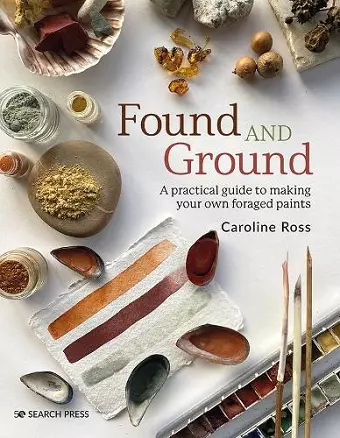Found and Ground
A Practical Guide to Making Your Own Foraged Paints
Format:Paperback
Publisher:Search Press Ltd
Published:30th Jun '23
Should be back in stock very soon

This guide teaches you to create natural paints, emphasizing sustainability and local foraging. Found and Ground inspires a creative, eco-friendly lifestyle.
In Found and Ground, readers are introduced to the art of creating natural watercolour paints, oak gall ink, and the essential brushes and pens for their application. This comprehensive guide emphasizes the principles of foraging for local materials, enabling individuals to craft their own unique paints while embracing a 'natural', 'no waste', and 'plastic-free' lifestyle. By following the methods outlined in this book, aspiring artists can cultivate a greener, more sustainable approach to their creative endeavors.
The narrative begins with a foreword by the esteemed author and environmentalist Paul Kingsnorth, setting the tone for a journey into the world of natural pigments. Found and Ground covers all aspects of paint-making, from sourcing raw materials to refining them into usable pigments. This resource is perfect for both beginners and those with prior experience in art, offering valuable insights for anyone looking to transition from commercial products to homemade alternatives.
With step-by-step instructions and clear explanations of any specialized terminology, Found and Ground is designed for a broad audience. It encourages artists and crafters to explore innovative techniques, including vegan 'egg paint' alternatives, while also providing fresh inspiration for those who may feel stuck in their creative routines. Ultimately, this book empowers readers to connect with their local environment, transforming everyday materials into vibrant works of art.
Publisher's Weekly This pleasant debut from artist Ross shows how to make paint pigments from chalk, clay, rocks, and other found materials. Providing tips on how to forage colorful materials in a variety of locales, she notes that readers might look for greenish shale in fields, pink clay at beaches, and orange discarded bricks in urban areas. Instructions outline how to turn the materials into pigments. For stones, Ross advises hammering them into tiny pieces, grinding the bits with a mortar and pestle, filtering the results through a sieve, then adding them to a jar with water, letting the mixture settle, and pouring out the standing water, which leaves behind only the finest sediments at the bottom of the jar. Transforming the pigment into watercolor paint requires more water and a medium to produce a more gel-like texture, which can be made with foraged solidified gum from cherry, acacia, or other "non-coniferous" trees. Ross details how different mediums create different looks, observing that substituting egg whites for gum results in a glossier finish. The finicky procedure might take some trial and error to master, but the comprehensive directions ensure readers are well prepared. The result is an enjoyable take on how artists can get in touch with the natural world.
ISBN: 9781800920996
Dimensions: unknown
Weight: unknown
128 pages